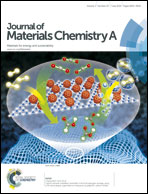Temperature-dependent structure and electrochemical performance of highly nanoporous carbon from potassium biphthalate and magnesium powder via a template carbonization process†
Abstract
We present a simple template carbonization method to produce nanoporous carbons in which potassium biphthalate and magnesium powder serve as the carbon source and hard template, respectively. It reveals that increasing the carbonization temperature can lead to an increase in crystallinity but porosity and the resultant electrochemical performance in supercapacitor application also decreases. The carbon-3 : 1-800 sample that was obtained by carbonizing potassium biphthalate and magnesium powder (mass ratio of 3 : 1) at 800 °C exhibits the best electrochemical performance. It has the largest BET surface area of 1745.6 m2 g−1 and a high pore volume of 1.46 cm3 g−1. When measured in a three-electrode system, the carbon-3 : 1-800 sample delivers a large specific capacitance of 234.2 F g−1 at a current density of 1 A g−1 and high capacitance retention of 96.6% even after 10 000 cycles. More importantly, the influence of the operation temperature of the carbon-3 : 1-800 sample on the electrochemical behavior was also investigated in a two-electrode system. The energy density can reach up to 96.9 W h kg−1 in the case of the power density of 1.5 kW kg−1; it also reveals that a higher operation temperature can result in better electrochemical performance, enabling its implementation under extreme circumstances.


 Please wait while we load your content...
Please wait while we load your content...